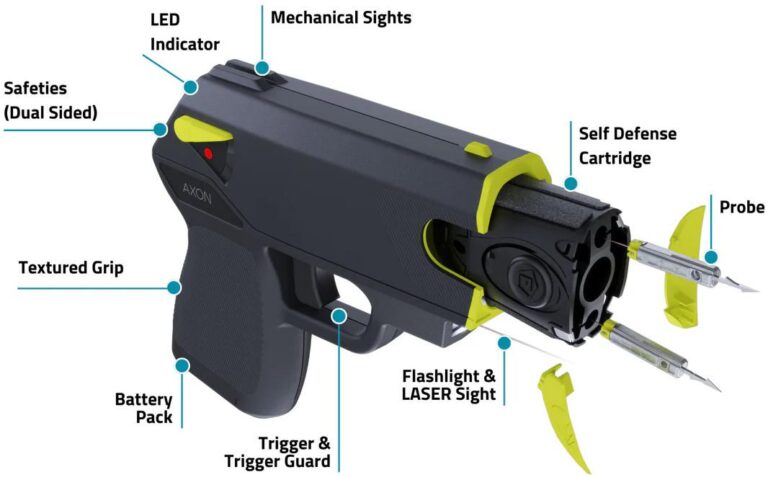Table of Contents
- Understanding the Mechanics Behind Stun Gun Activation
- Essential Techniques for Quick and Effective Deployment
- Safety Protocols to Minimize Risks During Use
- Choosing the Right Stun Gun for Optimal Performance and Reliability
- Final Thoughts
Understanding the Mechanics Behind Stun Gun Activation
When it comes to activating a stun gun, understanding the internal mechanics can significantly improve your response time and overall effectiveness. At the core of the device lies a high-voltage transformer that rapidly converts low-voltage battery power into a powerful electric charge. This charge is then discharged through exposed electrodes, creating an arc capable of temporarily immobilizing an attacker. The activation process is usually controlled by a safety switch or button, designed to prevent accidental discharge while ensuring quick deployment when needed.
To ensure seamless operation, familiarize yourself with the stun gun’s functional components, including:
- Power source: The batteries that supply the initial electrical energy.
- Trigger mechanism: A button or switch that completes the electric circuit.
- Electrodes: The metal prongs that emit the electric shock.
- Safety features: Locks or covers to prevent accidental activation.
Essential Techniques for Quick and Effective Deployment
Successfully activating your stun gun in high-pressure situations hinges on muscle memory and swift decision-making. Begin by practicing a consistent draw and activation technique-this involves securely gripping the device, quickly disengaging any safety mechanisms, and aiming accurately with minimal movement. Incorporating these steps into daily drills will help your reflexes become second nature, reducing hesitation when seconds count. Remember, the key lies in maintaining a calm mindset; training with simulated scenarios can enhance your ability to respond effectively, ensuring the stun gun is ready to deploy at a moment’s notice.
Equally important is understanding the proper grip and hand positioning for optimal control and comfort. Always hold the stun gun firmly, using your dominant hand, while keeping your support hand free to maintain balance or shield yourself. Consider practicing in front of a mirror or recording yourself to refine your stance and motions. To enhance deployment speed, familiarize yourself with the device’s ergonomics and switch between safety modes swiftly but safely. Incorporate these essential techniques into your routine, and you’ll elevate both your confidence and your capacity for fast, effective self-defense.
Safety Protocols to Minimize Risks During Use
When handling a stun gun, adhering to strict safety measures significantly reduces the risk of accidental injury. Always ensure the device is unloaded and deactivated when not in active use. Store it securely in a designated holster or case, out of reach of children and unauthorized individuals. Before carrying your stun gun, perform a quick visual and functional check to confirm it’s in proper working order without any visible damage. Remember, even a momentary lapse in attention can lead to unintended consequences, so treat every interaction with your stun gun as a serious responsibility.
Implementing the following best practices will help maintain control and prevent mishaps during use:
- Never point the stun gun at yourself or others unintentionally.
- Keep your finger off the activation button until you intend to use it.
- Understand the legal regulations in your area to avoid legal trouble.
- Practice activation drills in a safe environment to build muscle memory.
- Maintain a safe distance and aim for non-vital areas to minimize injury risks.
Choosing the Right Stun Gun for Optimal Performance and Reliability
When selecting a stun gun, prioritizing performance and reliability is essential to ensure effective self-defense. Look for models with a high voltage output that balances power without compromising safety during handling. Devices with built-in safety features such as activation switches and stun prongs designed for maximum contact improve both the device’s efficacy and user confidence. Additionally, choosing a stun gun with a durable casing made from impact-resistant materials means it can withstand rough conditions, guaranteeing performance when you need it most.
Equally important is the consideration of comfort and accessibility. Opt for stun guns that are lightweight and ergonomically designed to facilitate quicker activation under stress. Features to consider include:
- Compact size for discreet carrying and ease of use.
- Rechargeable batteries with long-lasting charge cycles to avoid power failures.
- Intuitive activation mechanisms that reduce fumbling during a critical moment.
Final Thoughts
In conclusion, mastering the activation of your stun gun is a crucial step toward ensuring both your safety and confidence in unpredictable situations. By familiarizing yourself with the device’s features, practicing proper handling, and understanding the legal considerations, you can respond quickly and effectively when it matters most. Remember, the goal of carrying a stun gun is not just to deter but to protect-with speed and responsibility. Stay informed, stay prepared, and prioritize safety every time you equip yourself for defense.Check Our Other Blogs
- StunGun – Your Trusted Source for Stun Guns, Laws, and Self-Defense Tips
- PepperSprayLaws – Your Trusted Resource for Pepper Spray Information
- StunGunLaws – Your Trusted Guide to Stun Gun Legality and Safety





